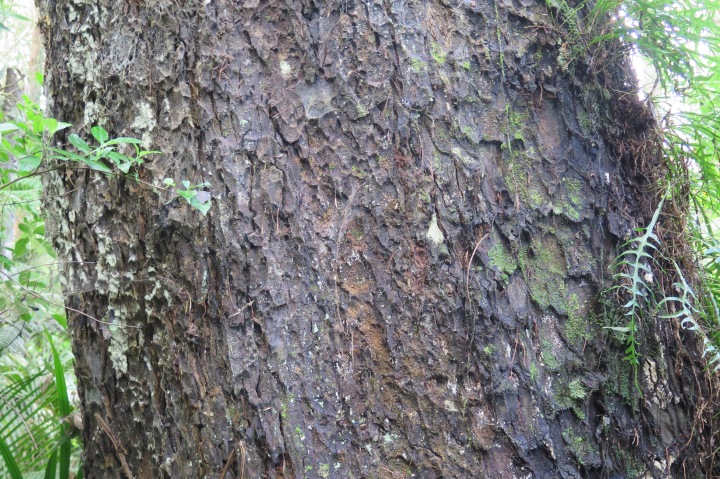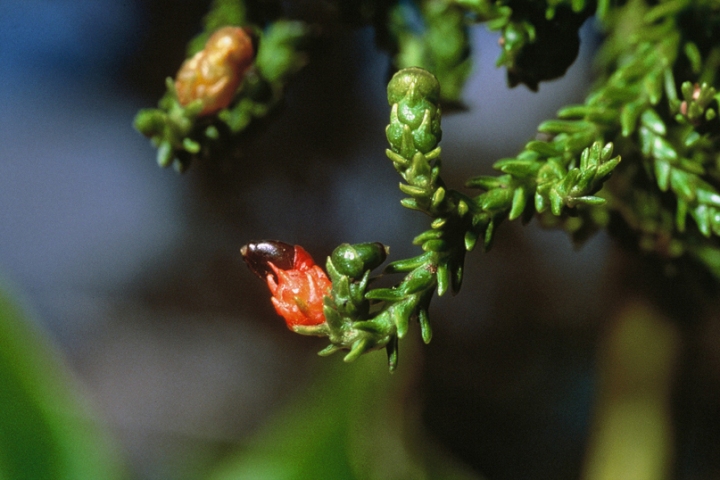The mature Rimu tree towers over the canopy with its weeping leaves and shedding bark. If not uprooted by strong winds or felled for timber, it can live to over 1000 years old and grow up to 50m tall. It is a member of the ancient Podocarp family whose lineage stretches back to a time when the New Zealand landmass was still part of the supercontinent Gondwana.

Rimu Wood
Rimu has long been considered one of New Zealand’s finest timbers, perhaps second only to Kauri. South of the Waikato where Kauri did not grow, Rimu or “Red Pine” was the dominant building timber used by European settlers. Because of extensive logging however, its range was greatly reduced and Government policies now prevent it from being logged on public land. Specialty items are still made from wood scavenged from stumps and roots of trees felled many years ago.
Edible Rimu Fruit

Māori used Rimu fruit as a food source, particularly in abundant mast years. The fruit only forms at the very end of branches, which made harvesting a dangerous task and serious injuries were common. The fruit has a constipating effect when eaten in large quantities and a juice made from Tutu flowers was drunk to counteract it.
Rimu and Kakapo
Rimu plays an integral role in the mating cycle of the Kākāpō – an extremely endangered, flightless, nocturnal parrot. The periodic mast-seeding of Rimu every couple of years helps synchronise Kākāpō mating efforts. Unripe Rimu fruit acts as ‘kākāpō viagra’ stimulating birds of both sexes into breeding, whereas the ripe fruit contains the perfect combination of nutrients and energy for growing chicks.
However if temperatures are not suitably warm the Rimu crop will fail, with devastating consequences on the tiny kākāpō breeding population. In the past, conservationists have attempted to boost Rimu fruiting frequency by spraying the trees with plant hormones, but the results were inconclusive. Today, work is focussed on developing supplementary diets and pills that mimic the benefits of Rimu fruit.
Uses
Rimu is a superior building wood, and was commonly used by early colonists in constructing houses, cabinets and furniture. Māori found a variety of uses for the wood aswell; as spears, canoes, torches and a host of other tools and implements.
The gum is bitter but edible and was applied to wounds to stop bleeding. A decoction of the bark was used to treat wounds, and was also bruised into a pulp and applied to burns, cuts and ulcers. It has been used to make brown, black and blue dyes. Ngāpuhi would mix soot from burning Rimu wood with shark-oil to make a black paint for their canoes.
On his second voyage to New Zealand, Captain Cook brewed Rimu beer to help prevent scurvy amongst his crew, and presumably to keep morale high aswell. The beverage was a great success, well appreciated by all on board. Cook wrote down the recipe and made another batch when he arrived in New Zealand again years later.
Captain Cook’s Recipe for Rimu Beer

- Boil small branches of rimu and mānuka in a large drum for three to four hours or until the bark can be stripped easily.
- Take the branches out and add as much molasses as required, 10 litres of molasses will make around 60 litres of beer.
- Pour the mixture into separate casks and add an equal quantity of cold water, according to your taste.
- When the mixture is milk-warm, add anything that will cause fermentation such as yeast or beer grounds.
- In a few days the beer will be fit to drink.






Rimu is my current favourite. Is there one in Albert Park?
LikeLike
Thanks Aiman.
Not as far as I know, but you can find one around the back of clock tower in the Auckland University campus
LikeLike
Thanks for the beer recipe! Keen to try this out!
LikeLike
No worries, thanks for reading – Let me know how it works out if you do!
LikeLike
Rimu is definitely my favourite NZ tree – we have a great short trail on the West Coast – Truman Track just north of Punakaiki with two fabulous examples – get hugs everytime I see them 🙂
LikeLiked by 1 person
Rimu might be my favourite too – they look so old and wise, towering over the forest.
Thats a good tip – If I am ever down that way I will make sure to look up the Truman Track
LikeLiked by 1 person
appreciate your take on the rimu….it is definitely my fav NZ tree and I love the way its adult shape seems to owe nothing to symmetry or indeed other trees. It is a ‘sad” or “spiritual” looking tree.We live in the middle of the Waitakeres west of Auckland and Rimu is our principle tree up here. I am very interested in its medicinal properties…if any….and also what potions or things can be made from its bark or gum…
LikeLike
What a gorgeous website! The information is so nicely presented, thank you ❤
LikeLiked by 1 person
I found this very amzing
LikeLike
I like this book this is my second time reading it
LikeLike
Thanks Jacob! Glad you are enjoying it.
LikeLike